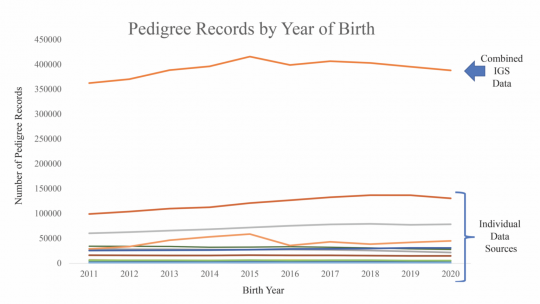Simmental NZ Joining IGS
Early in life, we are taught to share. Share with our siblings, share with our classmates, share with our neighbors. The fact that we have to learn this behavior is telling – it’s not instinctive. It’s human nature to protect what is “ours” and become territorial to ensure we have what we need to survive and thrive; however, we have seen how we all can do better by working together, sharing resources, and maybe most importantly, sharing ideas. This philosophy of comradery and collaboration is at the heart of the International Genetic Solutions (IGS).
IGS aims to serve the beef industry by providing resources for genetic improvement using the best technology available and unprecedented collaboration. The IGS collaboration has over 22 million animals and over 600,000 genotypes from 20 different organizations. Not only is it the largest beef cattle database, but it also has a huge amount of connectivity among the different organizations. Nearly ⅓ of the progeny records in the IGS evaluation have siblings in a separate database and multiple sires have progeny in as many as 17 databases. If each of these databases was an island with an isolated evaluation, the IGS team could breathe a little easier because the evaluation would be much simpler. But, it wouldn’t be better. It wouldn’t be as accurate. It wouldn’t give the best genetic predictions of the animals in the evaluation because more data is the key to more accurate genetic predictions.
Let’s talk through an example for Simmental New Zealand. There are 241 sires in the Simmental New Zealand database who also have progeny in another IGS database. By joining IGS, the Simmental New Zealand society adds 276,607 progeny records to these 241 sires. That is a 28 fold increase in progeny records on these bulls. One might think that only benefits that small number of sires, but this addition adds accuracy to all of their relatives which sprawls throughout the animals in the Simmental New Zealand database.
A visual way to see the IGS advantage is depicted in the following graphic. This graph shows the total data entering into the IGS evaluation (top line) compared to single breed society contributions at the bottom of the graph. The point illustrated here is that even the larger associations’ contributions are dwarfed by the IGS collective amount of data entering into the evaluation. We all improve our predictions by being a part of IGS.

It is complex to have one evaluation with 20 different data sources. It is challenging to have a multi-breed genetic evaluation and to account for different breed effects and heterosis. But at the end of the day, we want to provide the BEST possible genetic predictions, not only to seedstock breeders but for anyone using genetic predictions to select their future genetics.
The IGS model sets aside the territorial behaviors that crop up in breed societies. Instead of guarding our data, our material, our resources, to be used only to help our association improve, the IGS system opens the doors of communication among all the IGS partners to offer better resources to all the members and ultimately the beef industry. We all benefit from working together and sharing various perspectives from different breeds of cattle, different breed societies, and different countries but with the common goal of beef cattle genetic improvement. Beyond making the best possible genetic predictors, the staff from the various IGS partners learn from each other, share educational material, collaborate on different research projects, and work through various challenges most of us have faced independently but can get through better together.
IGS is excited to welcome Simmental New Zealand as our most recent addition to the IGS collaboration. This marks the forth Simmental breed society to join IGS – with Australian, Canadian, and United States welcoming in another Simmental society. While the future is unknown to all of us, it is certain to improve by working together towards the same common good.
By Jackie Atkins, PhD, Director of IGS Operations